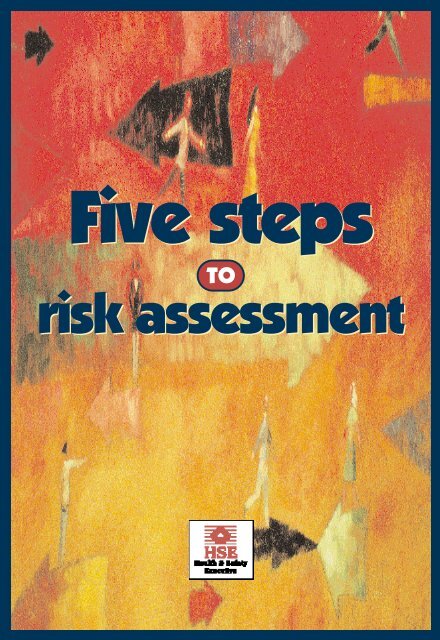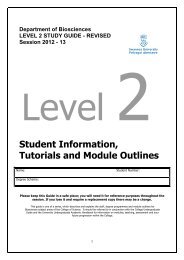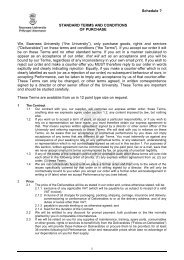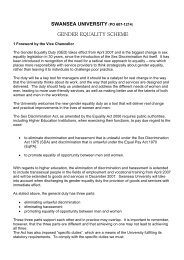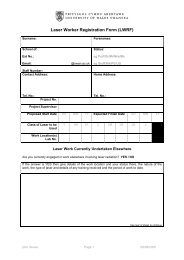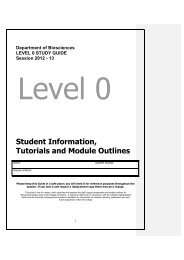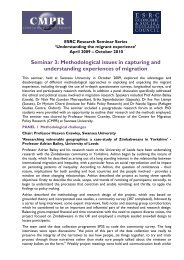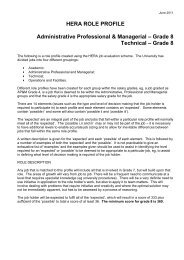five steps to risk assessment
five steps to risk assessment
five steps to risk assessment
You also want an ePaper? Increase the reach of your titles
YUMPU automatically turns print PDFs into web optimized ePapers that Google loves.
Five <strong>steps</strong><br />
TO<br />
<strong>risk</strong> <strong>assessment</strong>
5 <strong>steps</strong> <strong>to</strong><br />
RISK ASSESSMENT<br />
This leaflet<br />
aims <strong>to</strong> help<br />
employers<br />
and selfemployed<br />
people <strong>to</strong><br />
assess <strong>risk</strong>s<br />
in the workplace.<br />
It is<br />
aimed at<br />
firms in the<br />
commercial,<br />
service and<br />
light industrial<br />
sec<strong>to</strong>rs.<br />
What is <strong>risk</strong><br />
<strong>assessment</strong>?<br />
A <strong>risk</strong> <strong>assessment</strong> is nothing more than a<br />
careful examination of what, in your<br />
work, could cause harm <strong>to</strong> people, so<br />
that you can weigh up whether you have<br />
taken enough precautions or should do<br />
more <strong>to</strong> prevent harm. The aim is <strong>to</strong><br />
make sure that no one gets hurt or<br />
becomes ill. Accidents and ill health can<br />
ruin lives, and affect your business <strong>to</strong>o if<br />
output is lost, machinery is damaged,<br />
insurance costs increase, or you have <strong>to</strong><br />
go <strong>to</strong> court. You are legally required <strong>to</strong><br />
assess the <strong>risk</strong>s in your workplace.<br />
The important things you need <strong>to</strong> decide<br />
are whether a hazard is significant,<br />
and whether you have it covered by<br />
satisfac<strong>to</strong>ry precautions so that the <strong>risk</strong> is<br />
small. You need <strong>to</strong> check this when you<br />
assess the <strong>risk</strong>s. For instance, electricity<br />
can kill but the <strong>risk</strong> of it doing so in an<br />
office environment is remote, provided<br />
that ‘live’ components are insulated and<br />
metal casings properly earthed.<br />
2
e hurt. If so, check that you have taken<br />
what reasonable precautions you can <strong>to</strong><br />
avoid injury.<br />
How <strong>to</strong> assess the <strong>risk</strong>s<br />
in your workplace<br />
Follow the <strong>five</strong> <strong>steps</strong> in this leaflet:<br />
STEP 1: Look for the hazards<br />
STEP 2: Decide who might be<br />
harmed and how<br />
STEP 3: Evaluate the <strong>risk</strong>s and decide<br />
whether the existing precautions are<br />
adequate or whether more should<br />
be done<br />
STEP 4: Record your findings<br />
STEP 5: Review your <strong>assessment</strong> and<br />
revise it if necessary<br />
Don’t be overcomplicated. In<br />
most firms in the commercial, service<br />
and light industrial sec<strong>to</strong>rs, the hazards<br />
are few and simple. Checking them is<br />
common sense, but necessary. You<br />
probably already know whether, for<br />
example, you have machinery that could<br />
cause harm, or if there is an awkward<br />
entrance or stair where someone could<br />
If you are a small firm and you are<br />
confident you understand what’s<br />
involved, you can do the <strong>assessment</strong><br />
yourself (you don’t have <strong>to</strong> be a health<br />
and safety expert!). If you are a larger<br />
firm, you could ask a responsible<br />
employee, safety representative or safety<br />
officer <strong>to</strong> help you. If you are not<br />
confident, get help from a competent<br />
source (see under ‘Getting help’ on page<br />
8). But remember - you are responsible<br />
for seeing it is adequately done.<br />
Hazard and Risk -<br />
don’t let words in this<br />
guide put you off!<br />
hazard means anything<br />
that can cause<br />
harm (eg chemicals,<br />
electricity, working<br />
from ladders, etc)<br />
<strong>risk</strong> is the chance,<br />
high or low, that<br />
somebody will be<br />
harmed by the hazard.<br />
3
STEP 1<br />
Look for the<br />
hazards<br />
If you are doing the <strong>assessment</strong> yourself,<br />
walk around your workplace and look<br />
afresh at what could reasonably be<br />
expected <strong>to</strong> cause harm. Ignore the<br />
trivial and concentrate on significant<br />
hazards which could result in serious<br />
harm or affect several people.<br />
Ask your employees or their representatives<br />
what they think. They may have<br />
noticed things which are not immediately<br />
obvious. Manufacturers’ instructions or<br />
data sheets can also help you spot hazards<br />
and put <strong>risk</strong>s in their true perspective. So<br />
can accident and ill-health records.<br />
STEP 2<br />
Decide who<br />
might be harmed,<br />
and how<br />
Don’t forget:<br />
● young workers, trainees, new and<br />
expectant mothers, etc who may be<br />
at particular <strong>risk</strong><br />
● cleaners, visi<strong>to</strong>rs, contrac<strong>to</strong>rs,<br />
maintenance workers, etc who<br />
may not be in the workplace all<br />
the time<br />
● members of the public, or people<br />
you share your workplace with, if<br />
there is a chance they could be hurt<br />
by your activities.<br />
4
STEP 3<br />
Evaluate the <strong>risk</strong>s<br />
and decide<br />
whether existing<br />
precautions are<br />
adequate or more<br />
should be done<br />
Consider how likely it is that each<br />
hazard could cause harm. This will<br />
determine whether or not you need <strong>to</strong><br />
do more <strong>to</strong> reduce the <strong>risk</strong>. Even after<br />
all precautions have been taken, some<br />
<strong>risk</strong> usually remains. What you have <strong>to</strong><br />
decide for each significant hazard is<br />
whether this remaining <strong>risk</strong> is<br />
high, medium or low.<br />
First, ask yourself whether you have<br />
done all the things that the law says<br />
you have got <strong>to</strong> do. For example, there<br />
are legal requirements on prevention<br />
of access <strong>to</strong> dangerous parts of<br />
machinery. Then ask yourself whether<br />
generally accepted industry standards<br />
are in place. But don’t s<strong>to</strong>p there -<br />
think for yourself, because the law also<br />
says that you must do what is<br />
reasonably practicable <strong>to</strong> keep your<br />
workplace safe. Your real aim is <strong>to</strong><br />
make all <strong>risk</strong>s small by adding <strong>to</strong><br />
your precautions as necessary.<br />
If you find that something needs <strong>to</strong> be<br />
done, draw up an ‘action list’ and give<br />
priority <strong>to</strong> any remaining <strong>risk</strong>s which are<br />
high and/or those which could affect most<br />
people. In taking action ask yourself:<br />
a) can I get rid of the hazard<br />
al<strong>to</strong>gether?<br />
b) if not, how can I control the <strong>risk</strong>s<br />
so that harm is unlikely?<br />
In controlling <strong>risk</strong>s apply the principles<br />
below, if possible in the following order:<br />
● try a less <strong>risk</strong>y option<br />
● prevent access <strong>to</strong> the hazard<br />
(eg by guarding)<br />
● organise work <strong>to</strong> reduce exposure<br />
<strong>to</strong> the hazard<br />
● issue personal protective equipment<br />
● provide welfare facilities (eg washing<br />
facilities for removal of<br />
contamination and first aid)<br />
Improving health and safety need not<br />
cost a lot. For instance, placing a mirror<br />
on a dangerous blind corner <strong>to</strong> help<br />
prevent vehicle accidents, or putting<br />
some non-slip material on slippery <strong>steps</strong>,<br />
are inexpensive precautions considering<br />
the <strong>risk</strong>s. And failure <strong>to</strong> take simple<br />
precautions can cost you a lot more if an<br />
accident does happen.<br />
5
STEP 4<br />
But what if the work you do<br />
tends <strong>to</strong> vary a lot, or you or<br />
your employees move from<br />
one site <strong>to</strong> another? Identify the<br />
hazards you can reasonably expect and<br />
assess the <strong>risk</strong>s from them. After that, if<br />
you spot any additional hazards when<br />
you get <strong>to</strong> a site, get information from<br />
others on site, and take what action<br />
seems necessary.<br />
But what if you share a workplace?<br />
Tell the other employers and<br />
self-employed people there about any<br />
<strong>risk</strong>s your work could cause them, and<br />
what precautions you are taking. Also,<br />
think about the <strong>risk</strong>s <strong>to</strong> your own workforce<br />
from those who share your workplace.<br />
But what if you have already<br />
assessed some of the <strong>risk</strong>s?<br />
If, for example, you use hazardous<br />
chemicals and you have already assessed<br />
the <strong>risk</strong>s <strong>to</strong> health and the precautions<br />
you need <strong>to</strong> take under the Control of<br />
Substances Hazardous <strong>to</strong> Health<br />
Regulations (COSHH), you can consider<br />
them ‘checked’ and move on.<br />
More information about legal requirements<br />
and standards can be found in the<br />
HSE publications An Introduction <strong>to</strong><br />
Health and Safety, Essentials of Health and<br />
Safety and Management of Health and<br />
Safety at Work: Approved Code of Practice.<br />
Details of these are given on page 8.<br />
Record your<br />
findings<br />
If you have fewer than <strong>five</strong> employees<br />
you do not need <strong>to</strong> write anything down,<br />
though it is useful <strong>to</strong> keep a written<br />
record of what you have done. But if you<br />
employ <strong>five</strong> or more people you must<br />
record the significant findings of your<br />
<strong>assessment</strong>. This means writing down<br />
the significant hazards and conclusions.<br />
Examples might be ‘Electrical<br />
installations: insulation and earthing<br />
checked and found sound’ or ‘Fume<br />
from welding: local exhaust ventilation<br />
provided and regularly checked’.<br />
You must also tell your employees about<br />
your findings.<br />
Suitable and sufficient -<br />
not perfect!<br />
Risk <strong>assessment</strong>s must be suitable and<br />
sufficient. You need <strong>to</strong> be able <strong>to</strong> show that:<br />
● a proper check was made<br />
● you asked who might be affected<br />
● you dealt with all the obvious<br />
significant hazards, taking in<strong>to</strong><br />
account the number of people who<br />
could be involved<br />
● the precautions are reasonable, and<br />
the remaining <strong>risk</strong> is low.<br />
6
STEP 5<br />
Keep the written record for future<br />
reference or use; it can help you if an<br />
inspec<strong>to</strong>r asks what precautions you<br />
have taken, or if you become involved<br />
in any action for civil liability. It can also<br />
remind you <strong>to</strong> keep an eye on particular<br />
hazards and precautions. And it helps <strong>to</strong><br />
show that you have done what the law<br />
requires. There is an example at the end<br />
of this guide which you may find<br />
helpful <strong>to</strong> refer <strong>to</strong>, but you can make<br />
up your own form if you prefer.<br />
To make things simpler, you can refer <strong>to</strong><br />
other documents, such as manuals, the<br />
arrangements in your health and safety<br />
policy statement, company rules,<br />
manufacturers’ instructions, your health<br />
and safety procedures and your arrangements<br />
for general fire safety. These may<br />
already list hazards and precautions. You<br />
don’t need <strong>to</strong> repeat all that, and it is up<br />
<strong>to</strong> you whether you combine all the<br />
documents, or keep them separately.<br />
Review your<br />
<strong>assessment</strong> and<br />
revise it if<br />
necessary<br />
Sooner or later you will bring in new<br />
machines, substances and procedures<br />
which could lead <strong>to</strong> new hazards. If<br />
there is any significant change, add <strong>to</strong><br />
the <strong>assessment</strong> <strong>to</strong> take account of the<br />
new hazard. Don’t amend your<br />
<strong>assessment</strong> for every trivial change,<br />
or still more, for each new job, but if<br />
a new job introduces significant new<br />
hazards of its own, you will want <strong>to</strong><br />
consider them in their own right and<br />
do whatever you need <strong>to</strong> keep the<br />
<strong>risk</strong>s down. In any case, it is good<br />
practice <strong>to</strong> review your <strong>assessment</strong><br />
from time <strong>to</strong> time <strong>to</strong> make sure that<br />
the precautions are still working<br />
effectively.<br />
7
Getting help<br />
Here’s a selection of practical guidance <strong>to</strong><br />
help you. If you are still stuck on the<br />
<strong>assessment</strong>, your local health and safety<br />
inspec<strong>to</strong>r can advise you on what <strong>to</strong> do.<br />
You will find most of what you need <strong>to</strong><br />
know about standards and legal<br />
requirements in:<br />
An introduction <strong>to</strong> health and safety<br />
INDG259 1997<br />
Essentials of health and safety at work<br />
ISBN 0 7176 0716 X 1995<br />
but you might also find the following<br />
useful:<br />
Management of health and safety at<br />
work: approved code of practice and<br />
guidance<br />
ISBN 0 7176 2488 9 2000<br />
Successful health and safety<br />
management HSG65<br />
ISBN 0 7176 1276 7 1997<br />
Guide <strong>to</strong> preparing a health and safety<br />
policy statement for a small business<br />
ISBN 0 7176 0424 1 1989<br />
Selecting a health and safety<br />
consultancy INDG133 1992<br />
Personal Protective Equipment at<br />
Work: Guidance on Regulations L25<br />
ISBN 0 7176 0415 2 1992<br />
Getting <strong>to</strong> grips with manual handling<br />
INDG143 2000<br />
Electrical safety and you INDG231<br />
1996<br />
Managing vehicle safety at the<br />
workplace INDG199 1995<br />
Workplace transport safety HSG136<br />
ISBN 0 7176 0935 9 1995<br />
Working with VDUs INDG36 1998<br />
Display screen equipment work:<br />
guidance on regulations L26<br />
ISBN 0 7176 0410 1 1992<br />
Whose <strong>risk</strong> is it anyway video<br />
HSE priced and free publications are<br />
available by mail order from HSE Books,<br />
PO Box 1999, Sudbury, Suffolk CO10 2WA<br />
Tel: 01787 881165 Fax: 01787 313995<br />
Website: www.hsebooks.co.uk (HSE<br />
priced publications are also available<br />
from bookshops.)<br />
COSHH: the new brief guide for<br />
employers INDG136 1996<br />
8
HSE offices<br />
Government Buildings,<br />
Phase 1,<br />
Ty Glas,<br />
Llanishen,<br />
CARDIFF CF14 5SH<br />
Tel: 029 2026 3000<br />
Fax: 029 2026 3120<br />
Inter City House,<br />
Mitchell Lane,<br />
Vic<strong>to</strong>ria Street,<br />
BRISTOL BS1 6AN<br />
Tel: 01179 886000<br />
Fax: 01179 262998<br />
The Marches House,<br />
Midway,<br />
NEWCASTLE-UNDER-LYME<br />
ST5 1DT<br />
Tel: 01782 602300<br />
Fax: 01782 602400<br />
14 Cardiff Road,<br />
LUTON<br />
LU1 1PP<br />
Tel: 01582 444200<br />
Fax: 01582 444320<br />
Priestley House,<br />
Priestley Road,<br />
BASINGSTOKE<br />
RG24 9NW<br />
Tel: 01256 404000<br />
Fax: 01256 404100<br />
39 Baddow Road,<br />
CHELMSFORD<br />
CM2 0HL<br />
Tel: 01245 706200<br />
Fax: 01245 706222<br />
St Dunstans House,<br />
201-211 Borough High Street,<br />
LONDON<br />
SE1 1GZ<br />
Tel: 020 7556 2100<br />
Fax: 020 7556 2200<br />
3 East Grinstead House,<br />
London Road,<br />
EAST GRINSTEAD<br />
RH19 1RR<br />
Tel: 01342 334200<br />
Fax: 01342 334222<br />
McLaren Building,<br />
35 Dale End,<br />
BIRMINGHAM<br />
B4 7NP<br />
Tel: 0121 607 6200<br />
Fax: 0121 607 6349<br />
5th Floor Belgrave House,<br />
1 Greyfriars,<br />
NORTHAMPTON<br />
NN1 2BS<br />
Tel: 01604 738300<br />
Fax: 01604 738333<br />
1st Floor,<br />
The Pearson Building,<br />
55 Upper Parliament Street,<br />
NOTTINGHAM<br />
NG1 6AU<br />
Tel: 01159 712800<br />
Fax: 01159 712802<br />
Marshalls Mill<br />
Marshall Street<br />
LEEDS<br />
LS11 9YJ<br />
Tel: 0113 283 4200<br />
Fax: 0113 283 4296<br />
Sovereign House,<br />
110 Queen Street,<br />
SHEFFIELD<br />
S1 2ES<br />
Tel: 0114 291 2300<br />
Fax: 0114 291 2379<br />
Arden House,<br />
Regent Centre,<br />
Regent Farm Road,<br />
Gosforth,<br />
NEWCASTLE-UPON-TYNE<br />
NE3 3JN<br />
Tel: 0191 202 6200<br />
Fax: 0191 202 6300<br />
Grove House,<br />
Sker<strong>to</strong>n Road,<br />
MANCHESTER<br />
M16 0RB<br />
Tel: 0161 952 8200<br />
Fax: 0161 952 8222<br />
Marshall House,<br />
Ringway,<br />
PRESTON<br />
PR1 2HS<br />
Tel: See Manchester<br />
Fax: 01772 836222<br />
Belford House,<br />
59 Belford Road,<br />
EDINBURGH<br />
EH4 3UE<br />
Tel: 0131 247 2000<br />
Fax: 0131 247 2121<br />
375 West George Street,<br />
GLASGOW<br />
G2 4LW<br />
Tel: 0141 275 3000<br />
Fax: 0141 275 3100<br />
Offshore Division,<br />
Lord Cullen House,<br />
Fraser Place<br />
ABERDEEN AB25 3UB<br />
Tel: 01224 252500<br />
Fax: 01224 252662<br />
9
Hazard<br />
STEP 1<br />
Look only for hazards which you<br />
could reasonably expect <strong>to</strong> result in<br />
significant harm under the<br />
conditions in your workplace. Use<br />
the following examples as a guide<br />
● slipping/tripping hazards (eg<br />
poorly maintained floors or stairs)<br />
● fire (eg from flammable<br />
materials)<br />
● chemicals (eg battery acid)<br />
● moving parts of machinery<br />
(eg blades)<br />
● work at height (eg from<br />
mezzanine floors)<br />
● ejection of material (eg from<br />
plastic moulding)<br />
● pressure systems (eg steam<br />
boilers)<br />
● vehicles (eg fork-lift trucks)<br />
● electricity (eg poor wiring)<br />
● dust (eg from grinding)<br />
● fumes (eg welding)<br />
● manual handling<br />
● noise<br />
● poor lighting<br />
● low temperature<br />
STEP 2<br />
Who might<br />
be harmed?<br />
There is no need <strong>to</strong> list<br />
individuals by name - just<br />
think about groups of<br />
people doing similar work<br />
or who may be affected, eg<br />
●<br />
●<br />
●<br />
●<br />
●<br />
●<br />
●<br />
office staff<br />
maintenance personnel<br />
contrac<strong>to</strong>rs<br />
people sharing your<br />
workplace<br />
opera<strong>to</strong>rs<br />
cleaners<br />
members of the public<br />
Pay particular attention <strong>to</strong>:<br />
●<br />
●<br />
●<br />
●<br />
staff with disabilities<br />
visi<strong>to</strong>rs<br />
inexperienced staff<br />
lone workers<br />
They may be more<br />
vulnerable<br />
STEP 3<br />
Is more needed<br />
<strong>to</strong> control the<br />
<strong>risk</strong>?<br />
For the hazards listed, do the<br />
precautions already taken:<br />
●<br />
●<br />
●<br />
●<br />
meet the standards set by a legal<br />
requirement?<br />
comply with a recognised<br />
industry standard?<br />
represent good practice?<br />
reduce <strong>risk</strong> as far as reasonably<br />
practicable?<br />
Have you provided:<br />
●<br />
●<br />
adequate information,<br />
instruction or training?<br />
adequate systems or procedures?<br />
If so, then the <strong>risk</strong>s are adequately<br />
controlled, but you need <strong>to</strong> indicate<br />
the precautions you have in place.<br />
(You may refer <strong>to</strong> procedures,<br />
company rules, etc.)<br />
Where the <strong>risk</strong> is not adequately<br />
controlled, indicate what more you<br />
need <strong>to</strong> do (the ‘action list’)<br />
Review and revision<br />
STEP 5<br />
Set a date for review of the <strong>assessment</strong> (see opposite).<br />
On review check that the precautions for each hazard still adequately control the <strong>risk</strong>. If not indicate the action<br />
needed. Note the outcome. If necessary complete a new page for your <strong>risk</strong> <strong>assessment</strong>.<br />
Making changes in your workplace, eg when bringing in new<br />
● machines<br />
● substances<br />
● procedures<br />
may introduce significant new hazards. Look for them and follow the 5 <strong>steps</strong>.
RISK ASSESSMENT FOR<br />
Company Name<br />
Company Address<br />
Postcode<br />
STEP 1<br />
STEP 2<br />
ASSESSMENT<br />
UNDERTAKEN<br />
(date)<br />
Signed<br />
Date<br />
ASSESSMENT<br />
REVIEW<br />
Date<br />
STEP 3<br />
List significant hazards here:<br />
List groups of people<br />
who are at <strong>risk</strong> from the<br />
significant hazards you<br />
have identified:<br />
List existing controls or note<br />
where the information may be<br />
found. List <strong>risk</strong>s which are not<br />
adequately controlled and the<br />
action needed:
5 <strong>steps</strong> <strong>to</strong><br />
RISK ASSESSMENT<br />
HSE priced and free publications are<br />
available by mail order from HSE Books,<br />
PO Box 1999, Sudbury, Suffolk CO10 2WA<br />
Tel: 01787 881165 Fax: 01787 313995<br />
Website: www.hsebooks.co.uk (HSE<br />
priced publications are also available<br />
from bookshops.)<br />
For information about health and safety<br />
ring HSE's InfoLine Tel: 08701 545500<br />
Fax: 02920 859260 e-mail:<br />
hseinformationservices@natbrit.com or<br />
write <strong>to</strong> HSE Information Services,<br />
Caerphilly Business Park, Caerphilly<br />
CF83 3GG. You can also visit HSE’s<br />
website: www.hse.gov.uk<br />
This leaflet contains notes on good<br />
practice which are not compulsory but<br />
which you may find helpful in<br />
considering what you need <strong>to</strong> do.<br />
This publication may be freely<br />
reproduced, except for advertising,<br />
endorsement or commercial purposes.<br />
The information is current at 5/99.<br />
Please acknowledge the source as HSE.<br />
INDG163(rev1) 4/02 C1000<br />
Printed and published by<br />
the Health and Safety Executive


